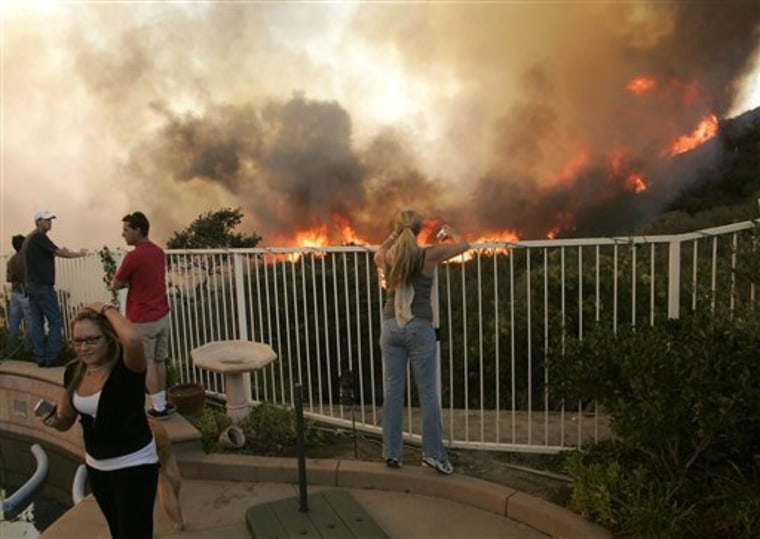Wildfires tearing through thousands of parched acres of Southern California are being fanned by unusually powerful seasonal winds that have whipped the flames with alarming speed, experts said Monday. And they warn that Californians might be in for more this winter.
The hot, dry Santa Ana winds typically blow between October and February, peaking in December. They blow from the northeast with steady speeds of at least 20 mph, and a spell typically lasts just a day or two.
This week's Santa Anas, though, started over the weekend and were not expected to diminish until Tuesday night.
"We have Santa Anas throughout the winter, but they tend to be more noticed this time of year because they're warmer and more likely to start fires," said Robert Fovell, professor of atmospheric and oceanic sciences at the University of California, Los Angeles.
The strong winds have stoked the flames and left residents little time to flee. The fires have killed at least one person, charred thousands of acres, destroyed scores of homes and forced the evacuation of hundreds of thousands of people.
Wind gusts were clocked at 108 mph at Whitaker Peak northwest of Los Angeles over weekend, and gusts of 85 mph were common below mountain passes and canyons, the Weather Service said. Sustained winds measured at 30 mph to 40 mph.
"For it to be this strong for so many days is unusual," said Stuart Seto, a specialist with the National Weather Service.
Where and how of the Santa Anas
The strong winds originate in the fall and winter in the Great Basin — the vast desert that covers much of Nevada, Utah and southern Idaho — when the desert is relatively cold.
The intensity of Santa Ana winds depends on the difference in pressure between a cool, high-pressure system in the Great Basin and a low-pressure system along coastal Southern California. The greater the pressure difference, the stronger the winds, which funnel through canyons and valleys and pick up speed as they sweep toward the coast.
With much of Southern California experiencing drought conditions this year, fast-moving Santa Anas, combined with high temperatures and low humidity, can increase the danger of wildfires and fan flames once blazes are ignited.
The root cause of most of the fires is still being investigated, but authorities believe some were caused by downed power lines, a vehicle fire and in one case, arson.
The last time Santa Anas caused major destruction in California was in 2003, when 15 wildfires raged, killing 22 people, destroying 3,640 homes and scorching 750,000 acres.
Santa Anas tripled last year
Last year, there were 78 Santa Ana days — more than three times the normal number, said Bill Patzert of NASA's Jet Propulsion Laboratory in Pasadena.
All indications show this winter will continue to be extremely dry, Patzert said.
"This is the beginning, unfortunately, of the Santa Ana season," Patzert said. "It looks like what's happening now is a preview of the coming attraction."
